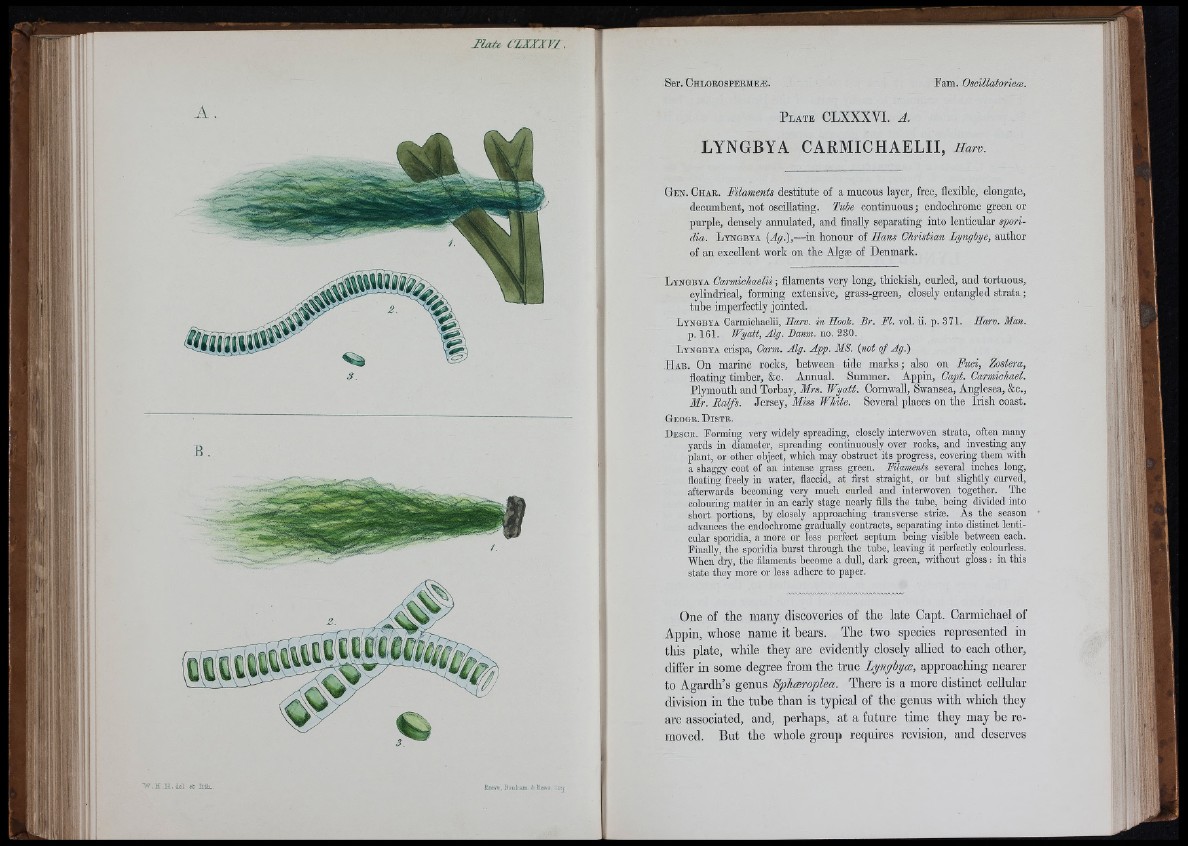
I'd
lîî
*! :
X
ii i i f . I, -
m I 1: I >17
/ ' I
iili
A .
E .
V^.H.H.del ib Eth.. R e e v t .B iu ih ia a ' R*f\8
P l a t e CLXXXVI. A.
LYNGBYA CARMICHAELII, Rarv.
G e n . C h a r . Mlaments destitute of a mucous layer, free, flexible, elongate,
decumbent, not oscillating. Tube continuous; endoclirome green or
purple, densely annulated, and finally separating into lenticular spori-
clia. L yngbya (Ag.),—in honour of Hans Christian Lyngbye, author
of an excellent work on the Algse of Denmark.
L yngbya Carmiohaelii ; filaments very long, thickish, curled, and tortuous,
cylindrical, forming extensive, grass-green, closely entangled strata ;
tube imperfectly jointed.
L y n g b y a Carmiohaelii, Harv. in Hook. Br. FI. vol. ii. p. 371. Harv. Man.
p. 161. Wyatt, Alg. Banm. no. 330.
L y n g b y a erispa, Oarm. Alg. App. MS. {not o f Ag.)
H a b . On marine rocks, between tide marks ; also on Fuci, Zostera,
floating timber, &c. Annual. Summer. Appin, Capt. Carmichael.
Plymouth and Torbay, Mrs. Wyatt. Cornwall, Swansea, Anglesea, &c.,
Mr. R a lfs. Jersey, Miss White. Several places on the Irish coast.
G e o g r . D i s t r .
D e s c r . Forming very widely spreading, closely interwoven strata, often many
yards in diameter, spreading continuously over rooks, and investing any
plant, or other object, which may obstruct its progress, covering them with
a shaggy coat of an intense grass green. Filaments several inches long,
floating freely in water, fiaccid, at first straight, or but slightly curved,
afterwards becoming very much cmded and interwoven together. The
colouring matter in an early stage nearly fiUs the tube, being divided into
short portions, by closely approaching transverse striæ. As the season
advances the endochrome gradually contracts, separating into distinct lenticular
sporidia, a more or less perfect septum being visible between each.
Finally, the sporidia burst through the tube, leaving it perfectly colourless.
When di-y, the filaments become a dull, dark green, without gloss ; in this
state they more or less adhere to paper.
One of the many discoveries of the late Capt. Carmichael of
Appin, whose name it bears. The two species represented in
this plate, while they are evidently closely allied to each other,
differ in some degree from the true Lynghya, approaching nearer
to Agardh’s genus Splmroplea. There is a more distinct cellular
division in the tube than is typical of the genus with which they
are associated, and, perhaps, at a future time they may be removed.
But the whole group requires revision, and deserves
' 1